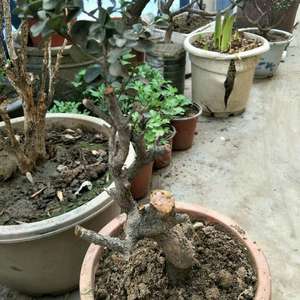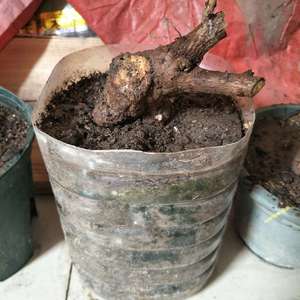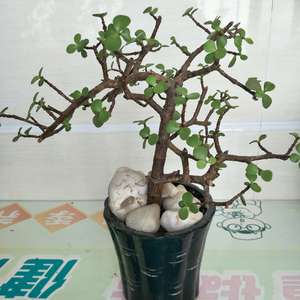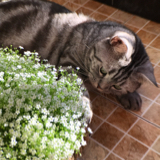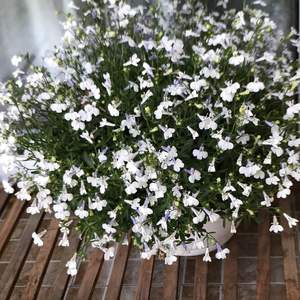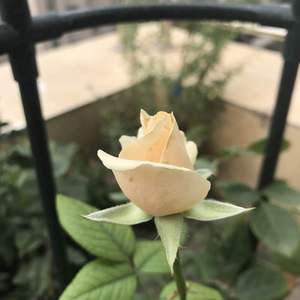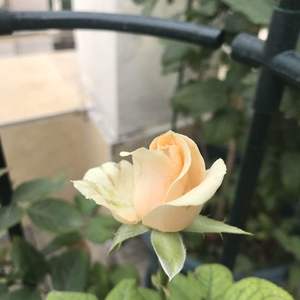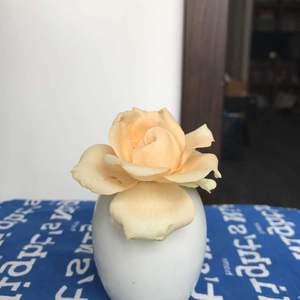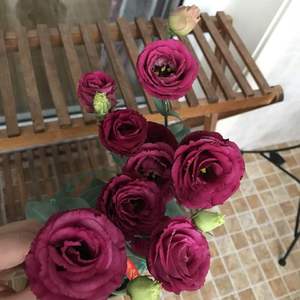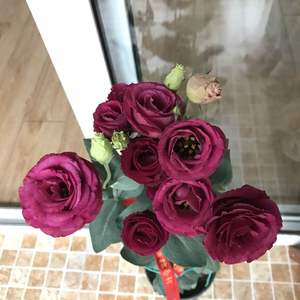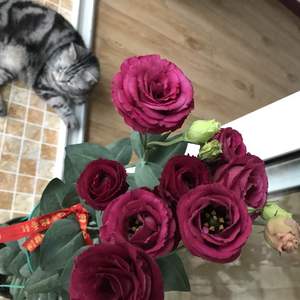文章
Miss Chen
2018年06月25日

6.Kalanchoe
So many of us only know these Kalanchoe as houseplants, forced into bloom at the florists. There are several hybrids with different forms, but all have flowers in clear, bright colors. Kalanchoe blossfeldiana is one of the most readily available. It can do quite well indoors but has the annoying habit of growing long and gangly and not wanting to flower again. When that happens,take a few cuttings and start over. It is frost tender.
7.Ice Plants (Lampranthus)
There are about 100 species of Lampranthus, succulents plants from South Africa. They have bright colored daisy-like flowers. The best known is the Ice Plant, Lampranthus multiradiatus. These look best massed and where they are hardy, they make a great ground cover or turf alternative, although I wouldn't walk on them. They are very forgiving. If you forget to water them, they just kept on blooming.
8.Sedum (stonecrop)
The tall Sedums, like ‛Autumn Joy' are wonderful showy, drought tolerant plants. Most bloom in late summer but look great for weeks as their broccoli-like flowers fill out. Even after blooming, the flowers just deepen in color and continue putting on a show. The creeping and trailing varieties have long been used in rock gardens and as ground covers. And they will cover ground very quickly. They have star-shaped blooms during the summer and are less attractive to deer than the tall varieties. You may see rabbits munching on them, though, probably for the water. Many varieties are extremely cold hardy.
9.Sempervivum
Hen and chicks have made a huge comeback. I remember them in my grandmother's garden and thought they were interesting, but not real flowers. I have become a total convert and enjoy spotting them tucked in throughout other's gardens.
Sempervivums are cold hardy, but a little touchy about long, hot, dry summers. They are perfect for all kinds of containers, from hypertufa troughs to strawberry jars.
These look a lot like Echeverias, but Sempervivum have pointed leaves that are a little thinner than Echeveria and they are more spherical.
10.Senecio
This is an odd group of plants, with bizarre shapes. The Candle Plants, Senecio articulatus, looks more like fingers, to me. Senecio talinoides var.mandraliscae, Blue Fingers, is icy blue-gray and these fingers are pointed. Then there's the perfectly charming Golden Groundsel, Senecio aureus, a ground cover with bright yellow, daisy-like flowers atop base rosettes. It's also hardy down to USDA Zone 4. Senecio rowleyanus (String of Beads or String of Pearls) looks more like a string of peas, but whatever it's called, it's striking.
So many of us only know these Kalanchoe as houseplants, forced into bloom at the florists. There are several hybrids with different forms, but all have flowers in clear, bright colors. Kalanchoe blossfeldiana is one of the most readily available. It can do quite well indoors but has the annoying habit of growing long and gangly and not wanting to flower again. When that happens,take a few cuttings and start over. It is frost tender.
7.Ice Plants (Lampranthus)
There are about 100 species of Lampranthus, succulents plants from South Africa. They have bright colored daisy-like flowers. The best known is the Ice Plant, Lampranthus multiradiatus. These look best massed and where they are hardy, they make a great ground cover or turf alternative, although I wouldn't walk on them. They are very forgiving. If you forget to water them, they just kept on blooming.
8.Sedum (stonecrop)
The tall Sedums, like ‛Autumn Joy' are wonderful showy, drought tolerant plants. Most bloom in late summer but look great for weeks as their broccoli-like flowers fill out. Even after blooming, the flowers just deepen in color and continue putting on a show. The creeping and trailing varieties have long been used in rock gardens and as ground covers. And they will cover ground very quickly. They have star-shaped blooms during the summer and are less attractive to deer than the tall varieties. You may see rabbits munching on them, though, probably for the water. Many varieties are extremely cold hardy.
9.Sempervivum
Hen and chicks have made a huge comeback. I remember them in my grandmother's garden and thought they were interesting, but not real flowers. I have become a total convert and enjoy spotting them tucked in throughout other's gardens.
Sempervivums are cold hardy, but a little touchy about long, hot, dry summers. They are perfect for all kinds of containers, from hypertufa troughs to strawberry jars.
These look a lot like Echeverias, but Sempervivum have pointed leaves that are a little thinner than Echeveria and they are more spherical.
10.Senecio
This is an odd group of plants, with bizarre shapes. The Candle Plants, Senecio articulatus, looks more like fingers, to me. Senecio talinoides var.mandraliscae, Blue Fingers, is icy blue-gray and these fingers are pointed. Then there's the perfectly charming Golden Groundsel, Senecio aureus, a ground cover with bright yellow, daisy-like flowers atop base rosettes. It's also hardy down to USDA Zone 4. Senecio rowleyanus (String of Beads or String of Pearls) looks more like a string of peas, but whatever it's called, it's striking.
0
1
文章
Miss Chen
2018年06月24日


6.Plant the Container
Once you are happy with the arrangement, remove the plants from the container, then begin removing them from their nursery pots and placing them back into the container, one-by-one. The soil in the nursery pots may be fairly coarse and loose, so be careful when removing the plants. Hold the plant gently at the top with the stem between two fingers. Turn the pot over on its side and gently tap the bottom of the pot and ease the plant out. (If you are handling a spiny succulent, make sure to use gloves when doing this.)
Once all plants are placed in the container, duplicating the design you want, gently pack additional succulent potting soil around each plant. As you do this, make sure to keep the plants at the same level they were growing at in their nursery pots—don't bury them deeper than they were already growing.
Make certain that you have filled in all the holes and spaces between the plants and also between the plants and the sides of the container. If you don’t, the roots will dry out, which can be lethal to your plant.

7.Finishing Touches
Gently remove any soil that is covering leaves and stems of the plants. You can do this with a soft-bristled brush, or even by gently blowing on the plants.
To give your container a finished look, cover the surface of the potting soil with a topdressing of some form of coarser stone, such as fine gravel, pebbles, sea glass, or marbles. The topdressing material can be brightly colored or neutral, depending on the look you want to achieve. Using a contrasting colored material for a topdressing can add zing to a pot; a more subtle topdressing can add elegance. The right topdressing can tie all the elements in your pot together or it can make plants stand out in contrast.

8.Caring for Your Succulents
To care for your succulent container garden, the goal is to mimic the conditions they would experience naturally.
During spring and summer—the growing season for most succulents— keep the soil moist, not wet. It's better to let the soil get a little dry between watering than it is to over-water. During the winter, when succulent plants are normally dormant, water much less frequently, keeping the soil on the dry side but not letting it dry out entirely.
Fertilization should be fairly minimal with succulent plants, and may not be needed at all. It will depend largely on the type of plants you are growing—research each species to learn its needs. If feeding is called for, do it only during the active growing season, using a diluted liquid fertilizer designed for succulents.
0
0
文章
Miss Chen
2018年06月21日

Description: This herbaceous perennial plant is usually unbranched and 2–3½' tall. The central stem is light green, terete, and sparingly to densely hairy. The alternate leaves are up 6" long and 1½" across, but they are typically about one-half of this maximum size. The rough-textured leaves are lanceolate in shape and coarsely serrated along their margins; they have a tendency to curl upward along their central veins. The lower leaves have short petioles, while the upper ones are sessile. The undersides of leaves usually have fine hairs.
The central stem terminates in a spike-like raceme of showy red flowers (rarely white). This raceme is about ½–1½' long. The red corolla of each flower has a narrow tubular structure that is upright and terminates in grayish white reproductive organs; these organs nod downward. Beneath this are 2 narrow lateral lobes and a lower lip that is 3-lobed. The green calyx is deeply divided into 5 linear teeth that spread outward. The flowers are held at an upward angle in relation to the stem; they are about 1–1½" long and ¾–1" across. The blooming period occurs from late summer to early fall, lasting about 1–1½ months. There is no floral scent. The small seeds can be carried aloft by the wind. The root system consists of a taproot.

Cultivation: The preference is light shade to full sun, and wet to moist conditions. Cardinal Flower adapts to loam, sandy loam, or gravelly soil; the soil should contain some organic matter to retain moisture. This plant doesn't like to dry out and it has a reputation of being temperamental and short-lived. It is easier to establish this plant using transplants, as the seeds are quite small and the young seedlings are rather fragile.

Range & Habitat: The native Cardinal Flower has been observed in most counties of Illinois; it is occasional to locally common in southern Illinois, while in northern and central Illinois it tends to be less common or absent (see Distribution Map). Habitats include wet prairies, prairie swales, openings in floodplain and bottomland woodlands, soggy meadows along rivers and streams, gravelly seeps and springs, borders of ponds, edges of small marshes, and ditches. These habitats include both sandy and non-sandy areas. Cardinal Flower is often found in sunny areas near sources of water, or it is found in open woodland areas where moist depressions occur.

Faunal Associations: The nectar of the flowers attracts the Ruby-Throated Hummingbird and various Swallowtail butterflies, including such species as Papilio polyxenes asterias (Black Swallowtail), Papilio troilus (Spicebush Swallowtail), and Battus philenor (Pipevine Swallowtail). Sometimes the larger bumblebees will steal nectar through slits in the tubular corolla. Halictid bees sometimes gather pollen, but they are ineffective at pollination. The larvae of a polyphagous fly, Metopomyza scutellata, mine the leaves of Cardinal Flower. The caterpillars of a moth, Enigmogramma basigera (Pink-washed Looper Moth), also feed on the leaves (Schweitzer & Roberts, 2007). The seeds are too small to be of much interest to birds. Mammalian herbivores usually don't consume this plant because of the toxic white latex in the foliage. While it's a beautiful plant, the ecological value of Cardinal Flower to wildlife is relatively low.
Photographic Location: Most of the photographs were taken by the webmaster at Meadowbrook Park in Urbana, Illinois; the plants were growing in a prairie swale. The photograph of a Cardinal Plant with rare white flowers was taken by Paul Showers (Copyright © 2013) in northeast Illinois.

Comments: The Cardinal Flower has striking red flowers that remind me of the Northern Cardinal and other exotic birds. Red is an unusual color in wildflowers – an attribute that it shares with Silene regia (Royal Catchfly) and Silene virginica (Fire Pink). Plants with red flowers typically attract hummingbirds; sometimes they also attract Swallowtail butterflies because their compound eyes, unlike those of bees, can detect the color red. The Cardinal Flower is often sold at garden centers, but such plants are often hybrids or special cultivars. One such hybrid is Lobelia X speciosa, which is a genetic cross of Lobelia cardinalis and Lobelia siphilitica (Great Blue Lobelia). This hybrid can naturalize in the wild, and resembles the former species to a greater extent than the latter. Its flowers are often magenta or deep rose, rather than brilliant red.
The central stem terminates in a spike-like raceme of showy red flowers (rarely white). This raceme is about ½–1½' long. The red corolla of each flower has a narrow tubular structure that is upright and terminates in grayish white reproductive organs; these organs nod downward. Beneath this are 2 narrow lateral lobes and a lower lip that is 3-lobed. The green calyx is deeply divided into 5 linear teeth that spread outward. The flowers are held at an upward angle in relation to the stem; they are about 1–1½" long and ¾–1" across. The blooming period occurs from late summer to early fall, lasting about 1–1½ months. There is no floral scent. The small seeds can be carried aloft by the wind. The root system consists of a taproot.

Cultivation: The preference is light shade to full sun, and wet to moist conditions. Cardinal Flower adapts to loam, sandy loam, or gravelly soil; the soil should contain some organic matter to retain moisture. This plant doesn't like to dry out and it has a reputation of being temperamental and short-lived. It is easier to establish this plant using transplants, as the seeds are quite small and the young seedlings are rather fragile.

Range & Habitat: The native Cardinal Flower has been observed in most counties of Illinois; it is occasional to locally common in southern Illinois, while in northern and central Illinois it tends to be less common or absent (see Distribution Map). Habitats include wet prairies, prairie swales, openings in floodplain and bottomland woodlands, soggy meadows along rivers and streams, gravelly seeps and springs, borders of ponds, edges of small marshes, and ditches. These habitats include both sandy and non-sandy areas. Cardinal Flower is often found in sunny areas near sources of water, or it is found in open woodland areas where moist depressions occur.

Faunal Associations: The nectar of the flowers attracts the Ruby-Throated Hummingbird and various Swallowtail butterflies, including such species as Papilio polyxenes asterias (Black Swallowtail), Papilio troilus (Spicebush Swallowtail), and Battus philenor (Pipevine Swallowtail). Sometimes the larger bumblebees will steal nectar through slits in the tubular corolla. Halictid bees sometimes gather pollen, but they are ineffective at pollination. The larvae of a polyphagous fly, Metopomyza scutellata, mine the leaves of Cardinal Flower. The caterpillars of a moth, Enigmogramma basigera (Pink-washed Looper Moth), also feed on the leaves (Schweitzer & Roberts, 2007). The seeds are too small to be of much interest to birds. Mammalian herbivores usually don't consume this plant because of the toxic white latex in the foliage. While it's a beautiful plant, the ecological value of Cardinal Flower to wildlife is relatively low.
Photographic Location: Most of the photographs were taken by the webmaster at Meadowbrook Park in Urbana, Illinois; the plants were growing in a prairie swale. The photograph of a Cardinal Plant with rare white flowers was taken by Paul Showers (Copyright © 2013) in northeast Illinois.

Comments: The Cardinal Flower has striking red flowers that remind me of the Northern Cardinal and other exotic birds. Red is an unusual color in wildflowers – an attribute that it shares with Silene regia (Royal Catchfly) and Silene virginica (Fire Pink). Plants with red flowers typically attract hummingbirds; sometimes they also attract Swallowtail butterflies because their compound eyes, unlike those of bees, can detect the color red. The Cardinal Flower is often sold at garden centers, but such plants are often hybrids or special cultivars. One such hybrid is Lobelia X speciosa, which is a genetic cross of Lobelia cardinalis and Lobelia siphilitica (Great Blue Lobelia). This hybrid can naturalize in the wild, and resembles the former species to a greater extent than the latter. Its flowers are often magenta or deep rose, rather than brilliant red.
2
0
成长记
choya8684
2018年06月18日

6/18加入黃金萬年草


1
0
choya8684:@Summers 其實不會耶,因為大顆的都是徒長狀態,組盆之後下層葉子幾乎都掉光所以才塞了萬年草進去
Summers:好像有點揹擠~
文章
Miss Chen
2018年06月18日

Description: This herbaceous perennial plant is unbranched and about 3-6' tall. The central stem is smooth and sometimes reddish. The alternate compound leaves are up to 2' long. They are often yellowish green, and become much smaller and sparser while ascending the central stem. Each compound leaf consists of 1-7 palmate leaflets that are aligned along each reddish leaf-stem in succession. Each leaflet is up to 6" long and across and has 2-5 cleft lobes. The margins are coarsely dentate.
The inflorescence occurs on a long naked stalk, consisting of a panicle of pink buds and flowers about 5-8" across. Each flower is about 1/3" across, consisting of 5 pink petals and numerous long white stamens with pink anthers. The overall appearance of the inflorescence resembles wind-tossed fluff or foam, and is quite beautiful. The flowers bloom from the bottom up, and have little or no fragrance. The blooming period occurs from early to mid-summer, and lasts about 3 weeks. Afterwards, straight reddish fruits develop that are about ¼–½" across. The root system consists of a taproot and rhizomes. Queen-of-the-Prairie tends to form colonies under moist conditions.
Cultivation: The preference is full or partial sun, and wet to moist conditions. The soil should be high in organic content, and can contain a little sand. The cooler climate of the Great Lakes region is preferred, rather than hot, dry summer heat. Occasionally, the leaves become spotted from foliar disease, otherwise it is not subject to any special problems.

Range & Habitat: The native Queen-of-the-Prairie occurs primarily in scattered counties along the upper basin of the Illinois River and in the Chicago area. It has also been observed in east central Illinois (see Distribution Map), where it has been successfully introduced. This uncommon plant is listed as 'threatened' in Illinois. Habitats include moist black soil prairies, moist sand prairies, moist meadows along rivers in woodland areas, shrubby fens, and wet areas in or around seeps and springs. This is an indicator plant of high quality habitats, although in some areas it has been introduced as part of restoration efforts.
Faunal Associations: The colorful flowers provide pollen as a reward for insect visitors, but not nectar. Various species of bees collect pollen from the flowers and probably are the most important pollinators. Beetles and flies feed on the pollen. Wasps and butterflies may land on the flowers looking for nectar, but their search will be futile. Little is known about the floral-fauna relationships for birds and mammals. The foliage doesn't seem to be bothered by deer and other herbivorous mammals.

Photographic Location: The photographs were taken at Meadowbrook Park in Urbana, Illinois.
Comments: This is a wonderful plant, if only it would bloom longer! In prairies, the pink flowers rise above the surrounding vegetation and can be seen from a considerable distance. It has a very distinctive appearance, and can't be confused with any other native plant. However, the introduced Filipendula ulmaria (Queen-of-the-Meadow) is somewhat similar. This latter species differs from Queen-of-the-Prairie by having white flowers and twisted fruits.
The inflorescence occurs on a long naked stalk, consisting of a panicle of pink buds and flowers about 5-8" across. Each flower is about 1/3" across, consisting of 5 pink petals and numerous long white stamens with pink anthers. The overall appearance of the inflorescence resembles wind-tossed fluff or foam, and is quite beautiful. The flowers bloom from the bottom up, and have little or no fragrance. The blooming period occurs from early to mid-summer, and lasts about 3 weeks. Afterwards, straight reddish fruits develop that are about ¼–½" across. The root system consists of a taproot and rhizomes. Queen-of-the-Prairie tends to form colonies under moist conditions.
Cultivation: The preference is full or partial sun, and wet to moist conditions. The soil should be high in organic content, and can contain a little sand. The cooler climate of the Great Lakes region is preferred, rather than hot, dry summer heat. Occasionally, the leaves become spotted from foliar disease, otherwise it is not subject to any special problems.

Range & Habitat: The native Queen-of-the-Prairie occurs primarily in scattered counties along the upper basin of the Illinois River and in the Chicago area. It has also been observed in east central Illinois (see Distribution Map), where it has been successfully introduced. This uncommon plant is listed as 'threatened' in Illinois. Habitats include moist black soil prairies, moist sand prairies, moist meadows along rivers in woodland areas, shrubby fens, and wet areas in or around seeps and springs. This is an indicator plant of high quality habitats, although in some areas it has been introduced as part of restoration efforts.
Faunal Associations: The colorful flowers provide pollen as a reward for insect visitors, but not nectar. Various species of bees collect pollen from the flowers and probably are the most important pollinators. Beetles and flies feed on the pollen. Wasps and butterflies may land on the flowers looking for nectar, but their search will be futile. Little is known about the floral-fauna relationships for birds and mammals. The foliage doesn't seem to be bothered by deer and other herbivorous mammals.

Photographic Location: The photographs were taken at Meadowbrook Park in Urbana, Illinois.
Comments: This is a wonderful plant, if only it would bloom longer! In prairies, the pink flowers rise above the surrounding vegetation and can be seen from a considerable distance. It has a very distinctive appearance, and can't be confused with any other native plant. However, the introduced Filipendula ulmaria (Queen-of-the-Meadow) is somewhat similar. This latter species differs from Queen-of-the-Prairie by having white flowers and twisted fruits.
0
1
文章
Miss Chen
2018年06月16日

Description: This perennial wildflower is 1½–6' tall, branching occasionally along the upper half of its length. The rather stout stems are light green to reddish purple (often the latter), terete to slightly grooved, and evenly covered with stiff spreading hairs. The alternate leaves are up to 6" long and 1¾" across, becoming gradually smaller along the upper half of each plant; they are narrowly lanceolate to lanceolate with poorly defined remote teeth along their margins. The leaves are yellowish green, medium green, or purple (sometimes the latter color during the fall); they are usually glabrous, except for some hairs along the central veins of their lower sides. Most leaves clasp the stems, although some of the smaller upper leaves are sessile.
The central stem terminates in a panicle of flowerheads; some lateral stems may produce smaller panicles of flowerheads. The branches of each panicle are ascending and usually hairy. Along these branches, there are linear-lanceolate leafy bracts up to 1" long. The outer branches terminate in flowerheads about ¾–1¼" across, consisting of 30-50 ray florets and a similar number of central disk florets. The petal-like rays are usually lavender, pale blue-violet, or purple (less often white); they are widely spreading and very slender. The tubular disk florets are 5-lobed; they are initially yellow, but later become dull red. At the base of each flowerhead, there are several overlapping bracts that are linear in shape, green, and hairless; they are rather loosely assembled around the base of the flowerhead and slightly spreading. The blooming period occurs from late summer into the fall and lasts about 2 months. Both disk and ray florets are fertile. The florets are replaced by bullet-shaped achenes about 1.5 mm. long that have small tufts of white hair; they are distributed by the wind. The root system is fibrous and short-rhizomatous, sometimes forming a small caudex on older plants.
Cultivation: The preference is full or partial sun and wet to moist conditions. The soil should contain some organic material to retain moisture and it should be reasonably fertile. Sometimes, the leaves become diseased and rather battered in appearance by the end of the year; the lower leaves may turn brown and fall off in response to droughty conditions. The size of individual plants can be highly variable.
Range & Habitat: The native Swamp Aster is occasional in the northern half of Illinois, while in the southern half of the state it is uncommon or absent. Habitats include soggy thickets along streams, open swamps, fens and calcareous seeps, sedge meadows, and other wetlands. Swamp Aster is often found in higher quality wetlands where the native flora is still intact. It is primarily a boreal species that is found around the Great Lakes and other cool areas.
Faunal Associations: The nectar and pollen of the flowerheads attract a wide variety of insects, including honeybees, bumblebees, other miscellaneous bees, various wasps, bee flies and other miscellaneous flies, and various butterflies, skippers, and moths. The oligolectic bees, Andrena asteris and Andrena hirticincta, suck nectar and collect pollen from the flowerheads of Swamp Aster. Other insects feed on the foliage, suck plant juices, bore through the stalks and roots, or gnaw on the flowers and developing seeds of Symphyotrichum spp. (asters). These species include Microrhopala xerene and other leaf beetles, several aphids (mostly Uroleucon spp.), the stinkbug Trichopepla semivittata, the leafhopper Macrosteles quadrilineatus, the plant bug Plagiognathus cuneatus, Poecilocapsus lineatus (Four-Lined Plant Bug), Lygus lineolaris (Tarnished Plant Bug), and the larvae of Calycomyza humeralis (Aster Leafminer Fly). In addition to these insects, a large number of moth caterpillars feed on asters (see the Moth Table for a listing of these species), as do the caterpillars of the butterflies Chlosyne nycteis (Silvery Checkerspot) and Phyciodes tharos (Pearl Crescent). Among vertebrate animals, the Wild Turkey eats the seeds and leaves occasionally, while the White-Tailed Deer and Cottontail Rabbit browse on the foliage.
Photographic Location: A low area along a pond at Weaver Park in Urbana, Illinois.

Comments: Except for Symphyotrichum novae-angliae (New England Aster), Swamp Aster has larger flowerheads than other Symphyotrichum spp. (asters) in Illinois and its flowerheads usually have more rays (about 30-50). It is a pretty hefty plant that is about as tall as New England Aster. This latter species has glandular hairs along its stems and its leaves are less shiny than those of Swamp Aster. Swamp Aster is divided into two varieties or subspecies: the typical variety/subspecies has evenly hairy purple stems, while variety/subspecies firmus (or lucidulous) has light green stems that are either hairless or the hairs are arranged in lines; sometimes the color of the stems is not reliable in making this distinction. The rhizomes of the typical variety/subspecies are supposed to be short, while the rhizomes of variety/subspecies firmus (or lucidulous) are supposed to be long. Some authors (e.g., Mohlenbrock, 2014), divide Swamp Aster into two separate species: Symphyotrichum puniceum and Symphyotrichum firmum. They have a similar distribution and are about equally common in Illinois. The preceding descriptive information and photos apply to Symphyotrichum puniceum puniceum. A scientific synonym of Swamp Aster is Aster puniceus.
The central stem terminates in a panicle of flowerheads; some lateral stems may produce smaller panicles of flowerheads. The branches of each panicle are ascending and usually hairy. Along these branches, there are linear-lanceolate leafy bracts up to 1" long. The outer branches terminate in flowerheads about ¾–1¼" across, consisting of 30-50 ray florets and a similar number of central disk florets. The petal-like rays are usually lavender, pale blue-violet, or purple (less often white); they are widely spreading and very slender. The tubular disk florets are 5-lobed; they are initially yellow, but later become dull red. At the base of each flowerhead, there are several overlapping bracts that are linear in shape, green, and hairless; they are rather loosely assembled around the base of the flowerhead and slightly spreading. The blooming period occurs from late summer into the fall and lasts about 2 months. Both disk and ray florets are fertile. The florets are replaced by bullet-shaped achenes about 1.5 mm. long that have small tufts of white hair; they are distributed by the wind. The root system is fibrous and short-rhizomatous, sometimes forming a small caudex on older plants.
Cultivation: The preference is full or partial sun and wet to moist conditions. The soil should contain some organic material to retain moisture and it should be reasonably fertile. Sometimes, the leaves become diseased and rather battered in appearance by the end of the year; the lower leaves may turn brown and fall off in response to droughty conditions. The size of individual plants can be highly variable.
Range & Habitat: The native Swamp Aster is occasional in the northern half of Illinois, while in the southern half of the state it is uncommon or absent. Habitats include soggy thickets along streams, open swamps, fens and calcareous seeps, sedge meadows, and other wetlands. Swamp Aster is often found in higher quality wetlands where the native flora is still intact. It is primarily a boreal species that is found around the Great Lakes and other cool areas.
Faunal Associations: The nectar and pollen of the flowerheads attract a wide variety of insects, including honeybees, bumblebees, other miscellaneous bees, various wasps, bee flies and other miscellaneous flies, and various butterflies, skippers, and moths. The oligolectic bees, Andrena asteris and Andrena hirticincta, suck nectar and collect pollen from the flowerheads of Swamp Aster. Other insects feed on the foliage, suck plant juices, bore through the stalks and roots, or gnaw on the flowers and developing seeds of Symphyotrichum spp. (asters). These species include Microrhopala xerene and other leaf beetles, several aphids (mostly Uroleucon spp.), the stinkbug Trichopepla semivittata, the leafhopper Macrosteles quadrilineatus, the plant bug Plagiognathus cuneatus, Poecilocapsus lineatus (Four-Lined Plant Bug), Lygus lineolaris (Tarnished Plant Bug), and the larvae of Calycomyza humeralis (Aster Leafminer Fly). In addition to these insects, a large number of moth caterpillars feed on asters (see the Moth Table for a listing of these species), as do the caterpillars of the butterflies Chlosyne nycteis (Silvery Checkerspot) and Phyciodes tharos (Pearl Crescent). Among vertebrate animals, the Wild Turkey eats the seeds and leaves occasionally, while the White-Tailed Deer and Cottontail Rabbit browse on the foliage.
Photographic Location: A low area along a pond at Weaver Park in Urbana, Illinois.

Comments: Except for Symphyotrichum novae-angliae (New England Aster), Swamp Aster has larger flowerheads than other Symphyotrichum spp. (asters) in Illinois and its flowerheads usually have more rays (about 30-50). It is a pretty hefty plant that is about as tall as New England Aster. This latter species has glandular hairs along its stems and its leaves are less shiny than those of Swamp Aster. Swamp Aster is divided into two varieties or subspecies: the typical variety/subspecies has evenly hairy purple stems, while variety/subspecies firmus (or lucidulous) has light green stems that are either hairless or the hairs are arranged in lines; sometimes the color of the stems is not reliable in making this distinction. The rhizomes of the typical variety/subspecies are supposed to be short, while the rhizomes of variety/subspecies firmus (or lucidulous) are supposed to be long. Some authors (e.g., Mohlenbrock, 2014), divide Swamp Aster into two separate species: Symphyotrichum puniceum and Symphyotrichum firmum. They have a similar distribution and are about equally common in Illinois. The preceding descriptive information and photos apply to Symphyotrichum puniceum puniceum. A scientific synonym of Swamp Aster is Aster puniceus.
0
0
文章
Miss Chen
2018年06月16日

Description: This perennial wildflower is an emergent aquatic about 3-8' tall, consisting of a small cluster of 2-5 deciduous basal leaves and a tall flowering stalk. The blades of basal leaves are 6-21" long and about one-third as much across; they are lanceolate to ovate in shape and smooth (entire) along their margins. The upper blade surface is pale green and glabrous, while the lower blade surface is whitish green and glaucous. Fine hairs are often present along the base, central veins, and margins of the blade underside. The erect petioles of basal leaves are 1½-3' long; they develop from a basal sheath. The petioles and basal sheath remain buoyant in water as a result of internal air cavities. The ascending blades diverge from their sheathed petioles at an angle. Leaf venation is pinnate with lateral veins that are parallel, curving toward the blade tips as they approach the margins.
An erect or ascending stalk about 4-8' tall terminates in a floral panicle about 4-18" long with a leafy bract at its base that is early-deciduous. The lateral branches of the panicle are ascending to drooping and slightly zigzag; they are reddish brown, but covered with a white powdery bloom. The whitish purple flowers develop in pairs along these lateral branches, where they bloom in succession. Adjacent pairs of flowers are spaced about 3 mm. from each other. A pair of large floral bracts are located at the base of each pair of flowers; these bracts are powdery white. Each flower is about 10-17 mm. long, consisting of 3 sepals, 3 petals, an ovary with a single style, a single fertile stamen, and 3 staminodia (sterile stamens). The membranous sepals are about 2 mm. long and insignificant. The petals join together at the base, forming a short corolla tube. The fertile stamen and staminodia are highly modified petaloid structures; they are purple to whitish purple and showy. The hooded staminodium has a pair of trigger-like appendages that, when they are depressed, release an elastic style with a cup-shaped stigma, enabling cross-pollination of the flower. The blooming period occurs from mid- to late summer, lasting about 1 month (in Illinois). Afterwards, fertile flowers areDistribution Map replaced by globoid-ovoid seed capsules. Each capsule contains a single large seed about 8 mm. long that is dark brown, globoid-ovoid in shape, and smooth. The root system is rhizomatous, from which clonal colonies of plants are produced.
Cultivation: The preference is full sun, wet ground with up to 1½' of water, and muddy or clay soil with organic matter. This wildflower can be propagated by either its seeds or division of its rhizomes. It is hardy to Zone 5 or Zone 6 if the rhizomes are protected by standing water during the winter and a northern ecotype is selected.
Range & Habitat: The native Powdery Thalia has been found in Alexander County at the southern tip of Illinois, where it is rare and state-listed as 'endangered.' Elsewhere in the state, it is absent. Illinois lies along the northern range limit of this species; it is more common in areas further south. Habitats include margins of ponds, marshes, swamps, and wet ditches along roads. Powdery Thalia is cultivated occasionally as an ornamental plant for ponds and wetland gardens.
Faunal Associations: The unusual flowers rely on explosive secondary pollination. The anther of the fertile stamen drops pollen grains onto a depression of the elastic style (immediately behind its stigma) during evening hours. The following morning, flower-visiting insects can trigger an appendage of the hooded staminodium, releasing the elastic style with its load of pollen. This area of the style strikes near the insect's head. The flowers of Powdery Thalia are cross-pollinated by nectar-seeking carpenter bees (Xylocopa virginica) and possibly large bumblebees (Bombus spp.); flies and other smaller insects often become trapped by the elastic styles of the flowers and die. Such floral visitors as large butterflies and hummingbirds are able to feed on nectar without triggering the explosive mechanism of pollen delivery; they are considered nectar thieves. The caterpillars of Calpodes ethlius (Brazilian Skipper) feed on the leaves of Powdery Thalia; they are leaf-rollers. This skipper does not successfully overwinter in Illinois, but it migrates northward and can reach the state during the summer. The large seeds are eaten by the Mallard, Lesser Scaup, and probably other ducks (Martin & Uhler, 1939).

Photographic Location: A botanical garden in Chicago, Illinois. The photographs were taken by Rita Ryan (Copyright © 2012).
Comments: Powdery Thalia is the only species in the Arrowroot family that is native to Illinois. It is a tropical-looking plant with large showy leaves and unusual purple flowers. The only other species of this genus that is native to the United States, Thalia geniculata (Alligator Flag), is found primarily in areas along the Gulf coast. It differs from Powdery Thalia by the lack of white powdery bloom on its foliage and flowers. In addition, the lateral floral branches of Alligator Flag are more zigzag than those of Powdery Thalia because adjacent pairs of its flowers are more widely spaced (at least 5 mm. apart).
An erect or ascending stalk about 4-8' tall terminates in a floral panicle about 4-18" long with a leafy bract at its base that is early-deciduous. The lateral branches of the panicle are ascending to drooping and slightly zigzag; they are reddish brown, but covered with a white powdery bloom. The whitish purple flowers develop in pairs along these lateral branches, where they bloom in succession. Adjacent pairs of flowers are spaced about 3 mm. from each other. A pair of large floral bracts are located at the base of each pair of flowers; these bracts are powdery white. Each flower is about 10-17 mm. long, consisting of 3 sepals, 3 petals, an ovary with a single style, a single fertile stamen, and 3 staminodia (sterile stamens). The membranous sepals are about 2 mm. long and insignificant. The petals join together at the base, forming a short corolla tube. The fertile stamen and staminodia are highly modified petaloid structures; they are purple to whitish purple and showy. The hooded staminodium has a pair of trigger-like appendages that, when they are depressed, release an elastic style with a cup-shaped stigma, enabling cross-pollination of the flower. The blooming period occurs from mid- to late summer, lasting about 1 month (in Illinois). Afterwards, fertile flowers areDistribution Map replaced by globoid-ovoid seed capsules. Each capsule contains a single large seed about 8 mm. long that is dark brown, globoid-ovoid in shape, and smooth. The root system is rhizomatous, from which clonal colonies of plants are produced.
Cultivation: The preference is full sun, wet ground with up to 1½' of water, and muddy or clay soil with organic matter. This wildflower can be propagated by either its seeds or division of its rhizomes. It is hardy to Zone 5 or Zone 6 if the rhizomes are protected by standing water during the winter and a northern ecotype is selected.
Range & Habitat: The native Powdery Thalia has been found in Alexander County at the southern tip of Illinois, where it is rare and state-listed as 'endangered.' Elsewhere in the state, it is absent. Illinois lies along the northern range limit of this species; it is more common in areas further south. Habitats include margins of ponds, marshes, swamps, and wet ditches along roads. Powdery Thalia is cultivated occasionally as an ornamental plant for ponds and wetland gardens.
Faunal Associations: The unusual flowers rely on explosive secondary pollination. The anther of the fertile stamen drops pollen grains onto a depression of the elastic style (immediately behind its stigma) during evening hours. The following morning, flower-visiting insects can trigger an appendage of the hooded staminodium, releasing the elastic style with its load of pollen. This area of the style strikes near the insect's head. The flowers of Powdery Thalia are cross-pollinated by nectar-seeking carpenter bees (Xylocopa virginica) and possibly large bumblebees (Bombus spp.); flies and other smaller insects often become trapped by the elastic styles of the flowers and die. Such floral visitors as large butterflies and hummingbirds are able to feed on nectar without triggering the explosive mechanism of pollen delivery; they are considered nectar thieves. The caterpillars of Calpodes ethlius (Brazilian Skipper) feed on the leaves of Powdery Thalia; they are leaf-rollers. This skipper does not successfully overwinter in Illinois, but it migrates northward and can reach the state during the summer. The large seeds are eaten by the Mallard, Lesser Scaup, and probably other ducks (Martin & Uhler, 1939).

Photographic Location: A botanical garden in Chicago, Illinois. The photographs were taken by Rita Ryan (Copyright © 2012).
Comments: Powdery Thalia is the only species in the Arrowroot family that is native to Illinois. It is a tropical-looking plant with large showy leaves and unusual purple flowers. The only other species of this genus that is native to the United States, Thalia geniculata (Alligator Flag), is found primarily in areas along the Gulf coast. It differs from Powdery Thalia by the lack of white powdery bloom on its foliage and flowers. In addition, the lateral floral branches of Alligator Flag are more zigzag than those of Powdery Thalia because adjacent pairs of its flowers are more widely spaced (at least 5 mm. apart).
0
0






